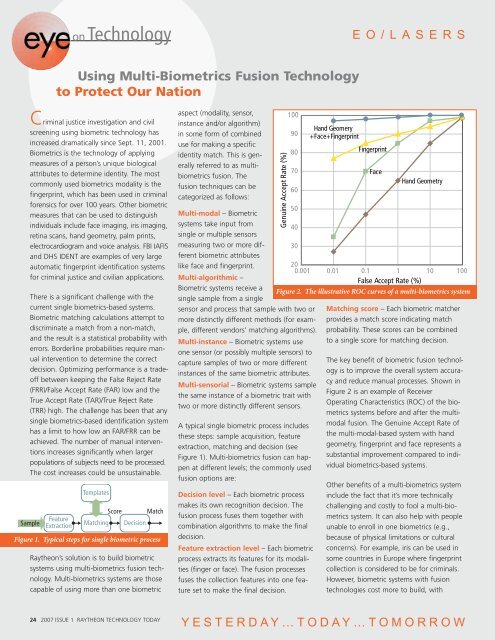Technology Today 2007 Issue 1 - Raytheon
Technology Today 2007 Issue 1 - Raytheon
Technology Today 2007 Issue 1 - Raytheon
Create successful ePaper yourself
Turn your PDF publications into a flip-book with our unique Google optimized e-Paper software.
on<strong>Technology</strong><br />
Using Multi-Biometrics Fusion <strong>Technology</strong><br />
to Protect Our Nation<br />
Criminal justice investigation and civil<br />
screening using biometric technology has<br />
increased dramatically since Sept. 11, 2001.<br />
Biometrics is the technology of applying<br />
measures of a person’s unique biological<br />
attributes to determine identity. The most<br />
commonly used biometrics modality is the<br />
fingerprint, which has been used in criminal<br />
forensics for over 100 years. Other biometric<br />
measures that can be used to distinguish<br />
individuals include face imaging, iris imaging,<br />
retina scans, hand geometry, palm prints,<br />
electrocardiogram and voice analysis. FBI IAFIS<br />
and DHS IDENT are examples of very large<br />
automatic fingerprint identification systems<br />
for criminal justice and civilian applications.<br />
There is a significant challenge with the<br />
current single biometrics-based systems.<br />
Biometric matching calculations attempt to<br />
discriminate a match from a non-match,<br />
and the result is a statistical probability with<br />
errors. Borderline probabilities require manual<br />
intervention to determine the correct<br />
decision. Optimizing performance is a tradeoff<br />
between keeping the False Reject Rate<br />
(FRR)/False Accept Rate (FAR) low and the<br />
True Accept Rate (TAR)/True Reject Rate<br />
(TRR) high. The challenge has been that any<br />
single biometrics-based identification system<br />
has a limit to how low an FAR/FRR can be<br />
achieved. The number of manual interventions<br />
increases significantly when larger<br />
populations of subjects need to be processed.<br />
The cost increases could be unsustainable.<br />
Figure 1. Typical steps for single biometric process<br />
<strong>Raytheon</strong>’s solution is to build biometric<br />
systems using multi-biometrics fusion technology.<br />
Multi-biometrics systems are those<br />
capable of using more than one biometric<br />
24 <strong>2007</strong> ISSUE 1 RAYTHEON TECHNOLOGY TODAY<br />
aspect (modality, sensor,<br />
instance and/or algorithm)<br />
in some form of combined<br />
use for making a specific<br />
identity match. This is generally<br />
referred to as multibiometrics<br />
fusion. The<br />
fusion techniques can be<br />
categorized as follows:<br />
Multi-modal – Biometric<br />
systems take input from<br />
single or multiple sensors<br />
measuring two or more different<br />
biometric attributes<br />
like face and fingerprint.<br />
Multi-algorithmic –<br />
Biometric systems receive a<br />
single sample from a single<br />
sensor and process that sample with two or<br />
more distinctly different methods (for example,<br />
different vendors’ matching algorithms).<br />
Multi-instance – Biometric systems use<br />
one sensor (or possibly multiple sensors) to<br />
capture samples of two or more different<br />
instances of the same biometric attributes.<br />
Multi-sensorial – Biometric systems sample<br />
the same instance of a biometric trait with<br />
two or more distinctly different sensors.<br />
A typical single biometric process includes<br />
these steps: sample acquisition, feature<br />
extraction, matching and decision (see<br />
Figure 1). Multi-biometrics fusion can happen<br />
at different levels; the commonly used<br />
fusion options are:<br />
Decision level – Each biometric process<br />
makes its own recognition decision. The<br />
fusion process fuses them together with<br />
combination algorithms to make the final<br />
decision.<br />
Feature extraction level – Each biometric<br />
process extracts its features for its modalities<br />
(finger or face). The fusion processes<br />
fuses the collection features into one feature<br />
set to make the final decision.<br />
E O / L A S E R S<br />
Figure 2. The illustrative ROC curves of a multi-biometrics system<br />
Matching score – Each biometric matcher<br />
provides a match score indicating match<br />
probability. These scores can be combined<br />
to a single score for matching decision.<br />
The key benefit of biometric fusion technology<br />
is to improve the overall system accuracy<br />
and reduce manual processes. Shown in<br />
Figure 2 is an example of Receiver<br />
Operating Characteristics (ROC) of the biometrics<br />
systems before and after the multimodal<br />
fusion. The Genuine Accept Rate of<br />
the multi-modal-based system with hand<br />
geometry, fingerprint and face represents a<br />
substantial improvement compared to individual<br />
biometrics-based systems.<br />
Other benefits of a multi-biometrics system<br />
include the fact that it’s more technically<br />
challenging and costly to fool a multi-biometrics<br />
system. It can also help with people<br />
unable to enroll in one biometrics (e.g.,<br />
because of physical limitations or cultural<br />
concerns). For example, iris can be used in<br />
some countries in Europe where fingerprint<br />
collection is considered to be for criminals.<br />
However, biometric systems with fusion<br />
technologies cost more to build, with<br />
Y E S T E R D A Y … T O D A Y … T O M O R R O W

















